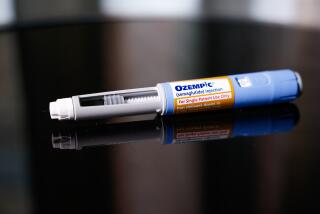Major Benefits Seen in Weight-Loss Surgeries
- Share via
Stomach reduction and gastric bypass surgery not only help the extremely obese lose weight, but can also alleviate Type 2 diabetes and return high cholesterol levels to normal, according to a new study reported today in the Journal of the American Medical Assn.
Dr. Henry Buchwald and colleagues at the University of Minnesota combined data from 136 studies involving 22,094 patients and concluded that the procedures -- which range from reducing the size of the stomach with a rubber band to complicated measures that bypass large parts of the digestive system -- are remarkably effective at restoring health.
They found that patients typically lost more than 60% of their excess weight, usually more than 100 pounds. Diabetes was resolved in nearly 77% of those with the disease. Cholesterol levels were lowered in at least 70% of patients. Blood pressure was returned to normal in nearly 62% of patients with high levels. Obstructive sleep apnea -- a breathing disorder -- was cured or improved in 83.6% of patients with that disorder.
Because these conditions are closely linked to obesity, the Minnesota team expected to see benefits from the procedures, but they “were a little surprised” by how large the benefits were, Buchwald said.
“The overwhelming majority of patients responded positively,” said Dr. Erik Dutson of UCLA, who performs the surgery but did not participate in the study. “This is a huge chunk of data that gives us very strong indications of what the reality is.”
At least 8 million Americans are considered morbidly obese -- more than 100 pounds overweight -- and have one or more other risk factors for heart disease that would make them eligible for the surgery. Many of them have tried dieting and appetite suppressants and failed.
These people have severe health risks because of their obesity, “and we are only doing the procedure on 1% or 2% of those who are eligible,” Buchwald said. “We couldn’t get away with that [rate of treatment] if this were AIDS or diabetes or anything else. This is the only therapy today that is this effective.”
The techniques, collectively called bariatric surgery, were developed in the 1950s and have been refined over time. Initially, they involved invasive surgery in which the chest was opened and a large segment of the intestines was bypassed, reducing absorption of food. The procedure required several days’ hospitalization, had many complications, and was never highly popular.
Beginning in the 1980s, Dr. Edward E. Mason of the University of Iowa developed what is known as the Roux-en-Y procedure, in which the upper portion of the stomach is stapled to reduce the amount of food it can hold, and a new outlet is formed in the stomach wall and connected to the lower intestine, bypassing much of the gastrointestinal tract. This is now the gold standard for bariatric surgery, and the Minnesota study found it to be the most effective.
Initially, it also required the chest to be opened, but most surgeons now do the procedure laparoscopically, inserting instruments into the abdomen through small incisions. Such techniques usually require only a short hospital stay.
The newest techniques, called banding, involve placing a rubber band around the upper portion of the stomach to limit food flow, thereby reducing the capacity of the stomach. In some cases, the band can be laparoscopically inflated to reduce stomach capacity, or deflated to increase it.
Buchwald found that the banding procedures were the least effective, but even they produced major benefits.
No one is sure how benefits are achieved. Limiting food intake and absorption in the intestines also reduced caloric intake. But the bypass operations almost always lead to reductions in appetite as well, through mechanisms that are not clear.
The popularity of the surgery has increased dramatically in recent years, spurred by reduced hospitalization times and the success stories of celebrities such as NBC weatherman Al Roker, singer Carnie Wilson and Sharon Osbourne. The number of procedures has increased from about 25,000 in 1998 to an estimated 144,000 this year, according to the American Society for Bariatric Surgery.
The procedures typically cost at least $25,000. But several studies have shown, Buchwald said, that the surgeries generally pay for themselves over a four-year period because they reduce the overall costs of healthcare.
The procedures have a broad range of side effects, including a small risk of death during the surgery, ranging from about 0.1% for banding procedures to 1.1% for the most complicated bypass operations, Buchwald found, but he noted that those rates were lower than the mortality seen for some other types of surgery.
Other complications include bleeding and infection. Because the bypass operations limit absorption of food, many patients do not get enough vitamins, and some have suffered from malnutrition. In most cases, none of these complications are considered severe or unmanageable.
The procedures that reduce stomach size also require a change in attitude toward eating, because it is physically impossible to consume large quantities. People who eat too much often get nauseated and vomit the excess. Some patients have popped staples in the stomach by overeating.
Counterbalancing those complications, however, are the severe side effects associated with obesity, including diabetes, heart disease, stroke, arthritis and other infirmities. Researchers estimate that a 25-year-old man who is morbidly obese will lose about 12 years of life as a result.
Most insurance companies pay for gastric bypass procedures but do not cover banding procedures -- perhaps, UCLA’s Dutson said, because they are the newest and thus least proven techniques.
In July, federal officials announced they were revising guidelines so that obesity would be considered an illness, paving the way for the procedures to be covered by Medicare.
Buchwald said he believed his study, which was funded by a Johnson & Johnson subsidiary that manufactures surgical instruments, bolstered the argument that insurance companies should cover all forms of the surgery for people who need it.






